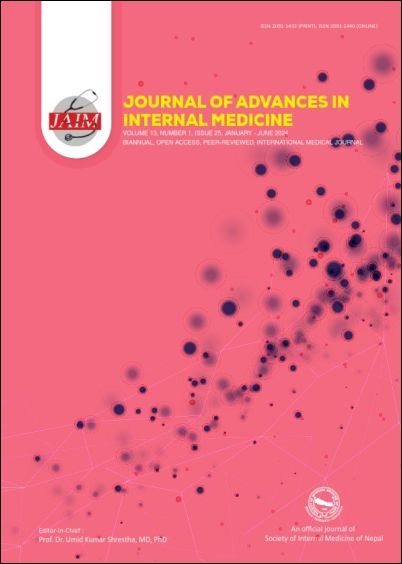A Comparative Study Between Patients with Community Acquired Acute Kidney Injury and Hospital Acquired Acute Kidney Injury from A Tertiary Care Hospital In Eastern Nepal
DOI:
https://doi.org/10.3126/jaim.v13i1.68486Keywords:
CA-AKI, Comparative study, HA-AKI, OutcomesAbstract
BACKGROUND Acute kidney injury is increasingly prevalent in both low and high income countries and is associated with increased morbidity and mortality. This study aims to compare the outcomes of community acquired AKI (CA-AKI) and hospital acquired AKI (HA-AKI) among patients admitted to the department of internal medicine, B.P.Koirala Institute Of Health Sciences (BPKIHS), Dharan.
METHODS The study was a hospital based prospective, observational study conducted in internal medicine ward of a tertiary care hospital. The study duration was one year, from November 2019 to October 2020. A total of 100 patients were enrolled out of which 50 were patients with CA-AKI and 50 were patients with HA-AKI. Demographic and serum creatinine at baseline, on the day of discharge or 7th day and after 3 months were collected using pre-designed questionnaire and recorded in a structured porforma. Patients were followed up at 3months after discharge to evaluate treatment outcome as recovery from AKI, chronic kidney disease (CKD), requirement for Renal Replacement Therapy and mortality in both groups.
RESULTS The mean age was 51.93±20.55 years with HA-AKI patients older than CA-AKI. Common co-morbidities were systemic hypertension(24% in CA-AKI and 34% in HA-AKI) followed by Diabetes mellitus(16% in CA-AKI and 28 in HA-AKI), CLD(6% in CA-AKI and 2% in HA-AKI), heart failure(6%in CA-AKI and 10% in HA-AKI).The mortality at 3 months was 20.00% in HA-AKI and 8.89% in CA-AKI. CKD was 8.88% in HA-AKI and 24.44% in CA-AKI. The need for hemodialysis was higher in CA-AKI patients than HA-AKI patients (14% vs. 2%; p=0.05). Most common cause of AKI in both the groups was infection. HA-AKI patients were found to have higher length of hospital stay than CA-AKI (8.5±6.8 days vs. 7.30±3.60 days; p=0.28) .
CONCLUSIONS Patients with CA-AKI seem to have a higher requirement for renal replacement therapy. Mortality or incidence of CKD was similar in both the groups at 3 months. HA-AKI patients were found to have higher length of hospital stay than CA-AKI.
Downloads
Downloads
Published
How to Cite
Issue
Section
License

This work is licensed under a Creative Commons Attribution 4.0 International License.
This license enables reusers to distribute, remix, adapt, and build upon the material in any medium or format, so long as attribution is given to the creator.




